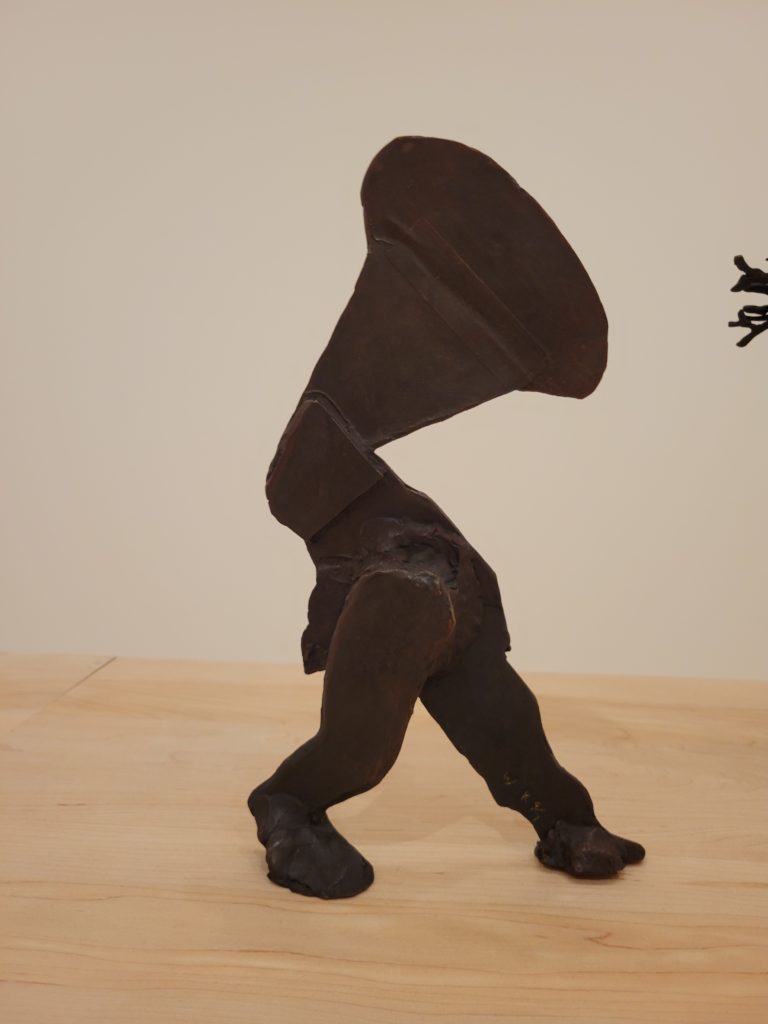
William Kentridge’s masterpiece of video project and audio landscaping presents a procession of “passionate absurd” figures and music representing the history of foreign political ideologies that have confronted and dominated the genius of Africa. In other works such as “The Head & the Load” he considers history “from the viewpoint of those who carried its burdens” and offers an “inventory of walking from the ordered advance of troops to the exhausted shuffle of the dying soldier; from the dancer’s leap to the porter’s trudge” (Maltz-Leca, 144).
In “More Sweetly Play the Dance’s” 180 degree projection, metal figures are used as animated shadow puppets and objects carried or dragged by live actors in the procession. The result is a black and white video which overlays hand drawn elements, crosshatching and even text that gives a timeworn quality “lo-res” and unsaturated colour to the composition. The work coordinates the tempo of a live musical and theatrical performance with shadows. The resulting panoramic video work provides both an overwhelming auditory and visual experience and a succession of provocative images. The roughly cast figures seem vaguely familiar – is that Lenin exhorting the crowds? The figure of Death with a sickle? These shadow images are dragged despondently or shaken beseechingly by the actors dressed as an impoverished populace. At other times, figures in military uniforms make speeches from platforms which could be anything from an execution platform to a parade float while marching bands follow behind.
Kentridge comments on the colonial past and the economic impact of the collision of different cultures using the motif of the procession and the marcher. The advantage of this motif is that viewers are well acquainted with the concept of a parade. His work filters abstract concepts, affective traumas and political critique through by mobilizing bodies and figures set to music. This allows him to communicate in the idiom of embodied rhythms. Similar to a dance, but organized as a linear processional tableau, the procession organizes and disciplines the presentation.
Kentridge’s projection of figures establishes a different relation and depth to a viewer: we see them side on, at a distance out of the side of our eyes then as if face to face, passing right by you. Collapsing history to the time and rhythm of procession on one hand. Depth extends the soundtrack to entangle the viewer in the processional space on the other. This is no longer a linear space of the projection but a more extensively dimensioned virtual space without clear boundaries and thus without limits. It is unlimited in extent but also extensive in more dimensions, if one can imagine multiple dimensions: axes of commentary, of the original time and space of the moments evoked for the viewer and of the time and space of the gallery that day – all stacked, entangled, reverberating: Listen to the sound. Because of it does the impossible in time-space terms, “More Sweetly Play the Dance” offers itself as its own utopian multidimensional time-space. Utopia, but critical reflecting on an epoch. Such is the power of the passionate absurd.
-Rob Shields (Univ. of Alberta)
References:
Leora Maltz-Leca “Footnotes to History: On Procession, Development and the State” in William Kentridge. A Poem that is Not Our Own (Exhibition catalogue). Kunstmuseum Basel. Basel: Verlag der Buchhandlung Walther König 2019 pp.139-161.
